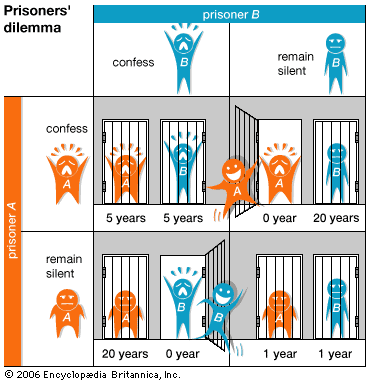The brilliance of ‘A Beautiful Mind’ was recognized again last week when John Nash the famous mathematician won the coveted Abel prize in Mathematics. John Nash is one of the very few mathematicians known in popular culture not only as a celebrity popularized by the movie ‘A Beautiful Mind’, but also for the ground breaking work in Game Theory. Ever since I watched the movie, my interest in Game Theory kept on growing and the more I understood the subject, the more I was seeing the dynamics of Game theory at play in everyday life. The easiest way to understand the concept is through the Prisoner’s Dilemma example, that is also used in real life by cops to get confession from suspects.
Prisoner’s Dilemma – The scenario
A and B are prisoners:
- They have been arrested for a petty crime, of which there is good evidence of their guilt – if found guilty they will receive a 1 year sentence each.
- During the interview the police officer becomes suspicious that the two prisoners are also guilty of a serious crime, but is not sure he has any evidence.
- A and B are placed in separate rooms and cannot communicate with each other. The police officer tries to get them to confess to the serious crime by offering them the below options.
The options
- Each is told that if they both confess to the serious crime they will receive a sentence of 5 years.
- However, each is also told that if he confesses and his partner does not, then he will go free, and his partner will get 20 years.
- They know that if they both deny the serious offence they are certain to be found guilty of the lesser offence, and will get a 1 year sentence.
The Dilemma
What would you do in such a situation? The dilemma is that your fate is wholly dependent on the behavior of the other – To avoid the cruel sentence of 20 years, is your safest option to confess and hope to go free or remain silent with the hope that the other person does not snitch on you?
Game Theory Analysis
This is how a game theorist would analyze the situation –
From Prisoner A’s Perspective:
Prisoner A has two options a) confess or b) remain silent. Let us see how these two decisions impact Prisoner A’s sentencing based on Prisoner B’s decision.
- If Prisoner B confesses – Prisoner A is better-off confessing than remain silent (look at first column – 5 years sentencing is better than 20 years sentencing for Prisoner A)
- If Prisoner B remains silent – Prisoner A is still better-off confessing than remain silent ( look at second column – go free / 0 years is better than 1 year of sentencing for Prisoner A)
As a result Prisoner A will opt to confess because in both the cases, pay-off from confessing is higher than remaining silent.
From Prisoner B’s Perspective:
The same logic applies. Prisoner B has two options a) confess or b) remain silent and his sentencing is dependent on Prisoner A’s decision.
- If Prisoner A confesses – Prisoner B is better-off confessing than remain silent (look at first row – 5 years sentencing is better than 20 years sentencing for Prisoner B)
- If Prisoner A remains silent – Prisoner B is still better-off confessing than remain silent (look at second row – go free / 0 years is better than 1 year of sentencing for Prisoner B)
As a result Prisoner B will opt to confess because in both the cases, pay-off from confessing is higher than remaining silent.
When each prisoner pursues his self-interest, both end up worse off than they would have been had they acted otherwise or cooperated with each other. This is called Nash Equilibrium.
“Nash Equilibrium is a stable state of a system involving the interaction of different participants, in which no participant can gain by a unilateral change of strategy if the strategies of the others remain unchanged”
You can see the concept of Nash Equilibrium in this famous scene from the movie ‘A Beautiful Mind’ where John Nash observes that the only way to get a girl is by cooperation.
Below are some examples of Game Theory at play around us –
- Price war between two competitors (e.g. Burger King and McDonalds)
- Arms race between two countries ( nicely explained by this Dove and Hawk model)
- Tit for Tat strategy used by Modi Government in discussions with Pakistan
- Employees outsmarting each other during performance appraisals to get higher ratings
- Athletes using performance enhancing drugs
- OPEC control over oil prices in competition with others
- Carbon emission by developing countries
- Domestically spouses wanting different things and end up doing something totally different
Below game is purely based on Prisoners Dilemma concept. See in the videos how cooperation and non-cooperation works. You will also learn of a tactic to force cooperation.
Our Darwinian instinct is that of competition, struggle for existence and survival of the fittest. Adam Smith’s model of development is that of competition – “In competition, individual ambition serves the common good”. Cooperation does not come about naturally to us and Game Theory clearly proves that the only way to succeed as John Nash puts it in the scene above – “…the best result would come from everyone in the group doing what is best for himself and the group.”

